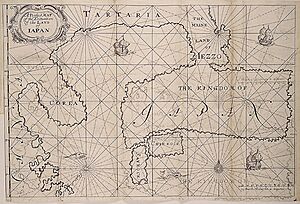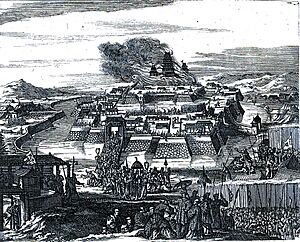François Caron facts for kids
Quick facts for kids
François Caron
|
|
|---|---|

A map of Japan in François Caron's "A True Description of the Mighty Kingdoms of Japan and Siam".
|
|
| 1st Director-General of the French East India Company | |
| In office 1667–1673 |
|
| 8th Governor of Formosa | |
| In office 1644–1646 |
|
| Preceded by | Maximiliaan le Maire |
| Succeeded by | Pieter Anthoniszoon Overtwater |
| 12th Opperhoofd in Japan | |
| In office 2 February 1639 – 13 February 1641 |
|
| Preceded by | Nicolaes Couckebacker |
| Succeeded by | Maximiliaan le Maire |
| Personal details | |
| Born | 1600 Brussels |
| Died | 5 April 1673 at sea, near Portugal |
| Nationality | Dutch, French |
| Spouse | Constantia Boudaen |
François Caron (French pronunciation: [fʁɑ̃swa kaʁɔ̃]; 1600–1673) was an important merchant and trader in the 17th century. He was born in Brussels to a family of Huguenots, who were French Protestants seeking safety in the Netherlands.
Caron worked for the Dutch East India Company (known as the VOC) for 30 years. He started as a cook's helper and rose to become a director-general in Batavia (now Jakarta, Indonesia). This was a very high position, just below the governor-general. After leaving the VOC in 1651, he was asked to lead the new French East Indies Company in 1665. He served there until he died in 1673.
Some people think Caron was the first Frenchman to visit Japan. However, he was born in Brussels, not France. He only became a French citizen later in life when he joined the French East Indies Company. The first known visit by a Frenchman to Japan was actually by Hasekura Tsunenaga in 1615.
Contents
Caron's Time in Japan

François Caron first arrived in Japan in 1619 as a cook's helper on a Dutch ship. He began working at the Dutch trading post in Hirado. By 1626, he became a full assistant there. He was very good at learning the Japanese language. He also had six children with a local woman.
In 1627, Caron became an interpreter for the VOC. He went on many diplomatic trips to Edo, which was the capital of the Shōgun (Japan's military ruler).
Rising Through the Ranks
On April 9, 1633, Caron was promoted to senior merchant. This made him the second most important VOC official in Japan. In 1636, the VOC Director-General asked Caron to answer 31 questions about Japan. Caron's answers became a book called Beschrijvinghe van het machtigh coninckrijcke Jappan ("Description of the Mighty Kingdom of Japan").
This book was published in 1645 and again in 1661. It was one of the first detailed reports about Japan for people in Europe. Many people read it, and it was translated into German, French, and English.
A Skilled Diplomat
Caron was a very good diplomat. He helped the Dutch keep good relations with the Shogunate, which was important for their trade. In 1636, he gave a beautiful copper lantern as a gift to the Shogun. This gift helped free Pieter Nuyts, a VOC ambassador who had caused a big problem.
On February 3, 1639, Caron became the opperhoofd (chief merchant) for the VOC in Japan. Around this time, Japan began strict isolationist policies. This meant they stopped almost all foreign trade and made it illegal to spread Christianity.
The Portuguese traders were completely expelled from Nagasaki. The Dutch were the only Europeans allowed to trade in Japan. However, they were forced to move their trading post from Hirado to a small artificial island called Dejima. Caron finished his term as opperhoofd just before this move happened in 1641.
Back to Europe and New Roles in Asia

In 1641, Caron's contract in Japan ended. He went to Batavia with his family, waiting to go back to Europe. He became a member of the Council of the East Indies, which was the main governing group for the VOC in Asia. On December 13, 1641, Caron sailed back to Europe.
He was rewarded well for his work. But he soon returned to Asia in 1643. When he arrived in Batavia, he learned that his Japanese partner had passed away. He asked for his children by her to be officially recognized, and this was accepted. Meanwhile, he had become engaged to Constantia Boudaen in Europe. She arrived in 1645, and they had seven more children together.
In 1644, Caron became the governor of Formosa (Taiwan). He was the main VOC official there until 1646. During this time, he improved the production of important goods like rice, sugar, and indigo. He also managed trade with Chinese pirates.
He returned to Batavia in 1646. In 1647, he was made director-general, the second-in-command after the governor-general. In 1651, Caron was called back to the Netherlands. He was accused of trading privately, but he successfully defended himself and was able to leave the company with honor.
Leading the French East Indies Company
In 1664, France decided to create its own trading company for Asia, called the French East Indies Company. Jean-Baptiste Colbert, a French minister, convinced Louis XIV to support it. Colbert then persuaded François Caron to become the company's Director General in 1665. The Dutch saw this as a betrayal, and Caron was banned from the Netherlands forever.
Plans for Japan and China
Caron believed that trading with Japan and China would make the French company rich. He suggested buying silks and other goods from China, then selling them in Japan for silver. This silver could then be used to buy more goods from China, creating a cycle of trade. He thought this was the only way for the French Company to become wealthy.
A letter from King Louis XIV to the Emperor of Japan was prepared. However, this plan never fully happened, and the letter was not delivered. It's likely it wouldn't have worked anyway, as Japan was very strict about its Sakoku (isolation) policy at that time.
French Outposts in Asia
In 1665, François Caron sailed to Madagascar. The French Company tried to set up a colony there but failed. Instead, they established ports on nearby islands like Bourbon (now Réunion) and Isle de France (now Mauritius).
Caron successfully founded French trading posts in India at Surat (1668) and Masulipatam (1669). King Louis XIV recognized his achievements by giving him the Order of St. Michael. He was in charge at Surat between 1668 and 1672. The French East India Company also set up a trading center at Pondicherry in 1673, which became the main French settlement in India.
In 1672, Caron helped lead French forces in Ceylon (now Sri Lanka). They captured a strategic bay at Trincomalee and also took St. Thomé (Meilâpûr) on the Coromandel coast. However, these successes did not last long. The French were driven out of these areas while Caron was sailing back to Europe in 1673.
François Caron died on April 5, 1673, when his ship sank near Lisbon, Portugal, while he was returning to Europe.
Honors
- Order of St. Michael, 1672
See also
- Nanban trade period
- Franco-Japanese relations


